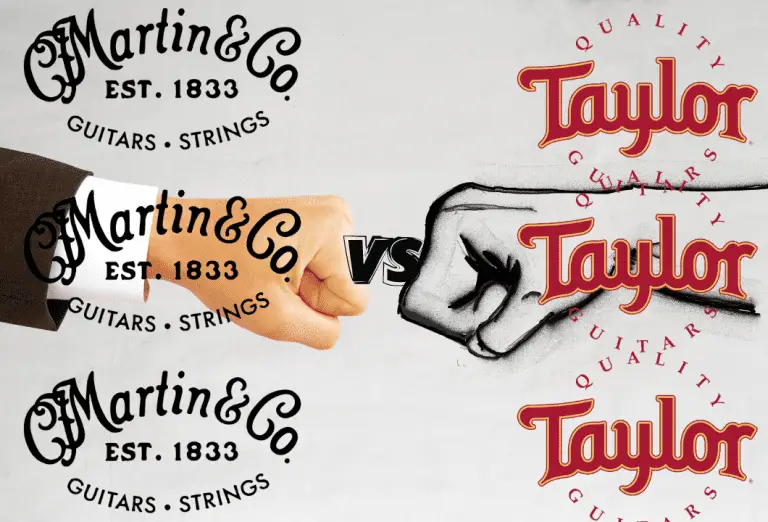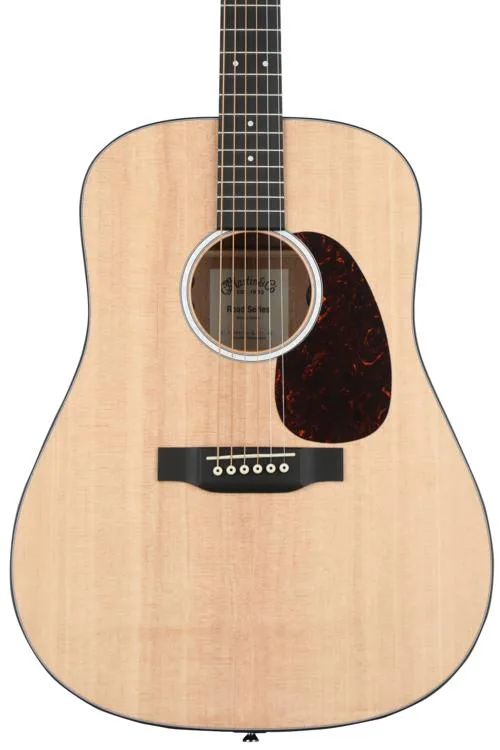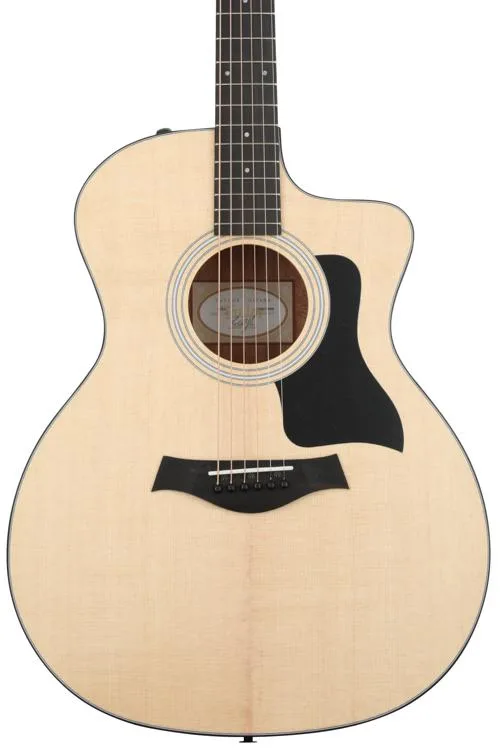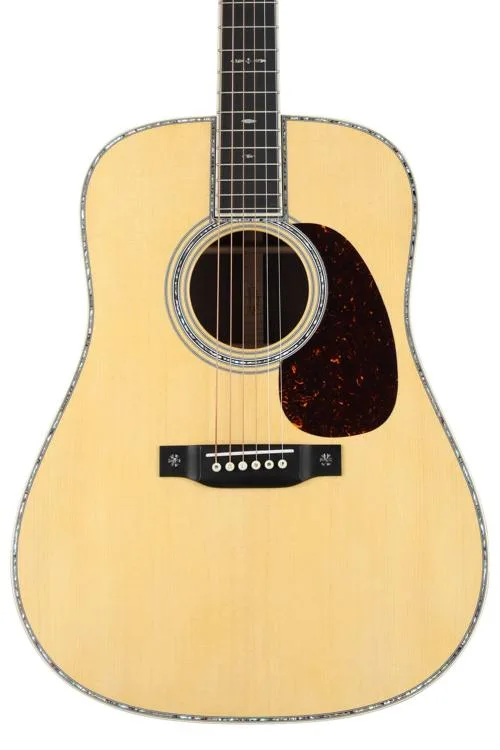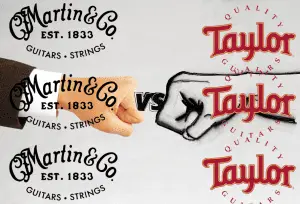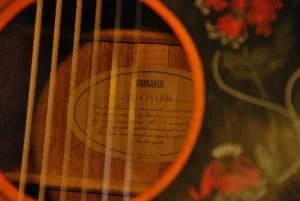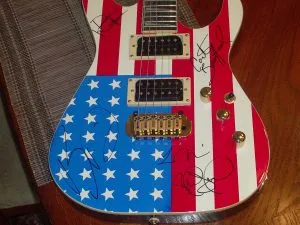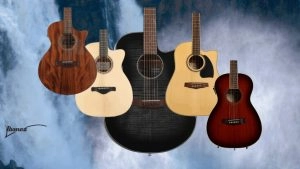Taylor and Martin are two acoustic guitar brands that don’t need an introduction. Both brands carry a legacy of quality construction, playability, and classic acoustic guitar tone.

Established in 1833, Martin is the elder statesman of the acoustic world. Perceived as the quintessential acoustic brand, Martin has set the bar for high-quality acoustics for almost 200 years.
Generally speaking, Taylor guitars are more contemporary in their history and features. Taylor acoustic and electric guitars are modern workhorses. They feature high-quality tonewoods and components ready for the studio, stage, or practice.
So, in the battle of Martin vs. Taylor, which brand is right for you? It’s hard to go wrong with these top-notch guitar manufacturers. But you’ll find distinct differences between the two legendary guitar builders.
• • •
Taylor Vs. Martin Guitars: Quick Overview
Taylor and Martin both offer high-quality, great-sounding guitars. You may already have some preconceived notions about both of these brands. But once you dive a little deeper and see what’s under the surface, what you find might surprise you.
• • •
Martin Vs. Taylor: What Are Their Respective Strengths?

In some ways, it’s challenging to compare Taylor guitars to Martin guitars. Taylor guitars sound and look more modern thanks to their advanced onboard electronics, features, armrests, and cutaways. Taylor guitars are everyday workhorses built for the road, studio, and stage.
Martin guitars are best known for their classic designs. They have remained popular for generations. Impeccable tone and playability are among Martin’s calling cards. Not to mention the gorgeous adornments that you’ll find on many of their models.
• • •
Where Martin and Taylor Guitars Shine

Before you can determine who wins the Martin vs. Taylor contest, you should take stock of how you’ll be using this guitar. Will you be using this instrument in a studio? Will you plug it into a recording console or PA soundboard? Will you even need to plug this guitar into anything at all?
These are all essential factors to consider before choosing a Martin or Taylor acoustic. Construction, bracing and onboard electronics will help determine which guitar works best for you.
Ready to compare Martin and Taylor guitars? Let’s find out which brand you should buy.
• • •
Taylor Vs. Martin: Same Difference?

For comparison, let’s start by looking at a flagship line from each brand: The Martin D28 and the Taylor 800 series.
Both of these guitar models feature a similar tonewood profile with solid Sitka spruce tops and Indian Rosewood backs and sides. Both feature top-notch craftsmanship and construction. Both sound incredible.
But once you start to look a little closer, you’ll find some key differences between these guitar brands. The D28 series has been around for over 90 years. And to this day, Martin sticks with the tradition set forth when they released the first D28 in 1931.
Taylor’s 800 series takes a modern approach with standard onboard electronics and cutaways.
Let’s dive in and take a closer look at some of the similarities, and differences, between Taylor and Martin guitars.
A Brief History Of Taylor And Martin Guitars
Both legendary guitar makers haven’t strayed far from their original formula for success.
The C.F. Martin & Company, abbreviated to Martin, was founded in 1883. Martin is one of the oldest guitar manufacturing companies in the world.
One of the primary descriptors you’ll see about vintage Martin guitars is “Pre-War.” While there have been many wars since 1883, Pre-War Martin guitars were made before World War II.

What makes Pre-War Martin guitars so unique? Most players point to scalloped bracing and a shift in tonewood construction due to war-related shortages.
Who plays Martin guitars? You might be better off asking who doesn’t or who hasn’t. Bob Dylan, Paul McCartney, Elvis Pressley, Sturgill Simpson, Paul Simon, Johnny Cash, Neil Young, and Willie Nelson are a handful of well-known Martin players.
Taylor guitars are more modern in both their age and approach to guitar building. According to their website, founded by Bob Taylor in 1974, Taylor guitars are “renowned for blending innovative manufacturing techniques with a master craftsman’s attention to detail” according to their website.
In my experience, this rings true thanks to Taylor’s remarkable dedication to fit and finish on their entire line of acoustics.
Taylor also features an impressive roster of famous recording artists who use their guitars. From Jewel to Jason Mraz and John Petrucci to Shawn Mendes. And then, of course, there’s that other Taylor who plays a Taylor guitar: Taylor Swift.
To this day, Martin and Taylor are among the most popular brands producing acoustic guitars — and for good reason.
With stellar natural acoustic tone and outstanding quality control, you know that you’ll be getting a perfectly crafted instrument when you purchase a Martin or Taylor guitar (1, 2)
Sound / Tone
Whether you opt for a Taylor guitar or a Martin guitar, you know that you’ll get a top-notch instrument with a classic acoustic tone.
Whereas Martin guitars are designed for a more traditional sound and style, Taylor produces guitars with contemporary updates and a more modern sound.

Both Taylor and Martin instruments feature tried and true tonewood combinations that give you that classic acoustic guitar sound and will age well.
In the Taylor and Martin guitar models that feature a Sitka spruce and rosewood combination, you’ll love the rich sound, excellent projection, and upper mid-tones that cut through the mix.
These guitars will only sound better as the years go on if you take good care of them.
However, that’s not to say that all Martin guitars are only geared toward nailing the traditional acoustic guitar sound. Not all Taylor guitar models are built to achieve a more modern sound.
Build Quality
There’s no denying that Taylor and Martin both boast impeccable build quality and craftsmanship. Both guitar manufacturers produce some of the best acoustic guitars available. While the quality of each of these legendary guitar makers isn’t up for debate, there are a few key differences in how a Taylor acoustic guitar is built compared to a Martin guitar.
I’d like to focus on the bracing commonly found in Martin and Taylor guitars in this section. Acoustic guitar bracing can be an unrecognized feature that significantly impacts your guitar’s sounds.

Martin guitars commonly feature X-shaped bracing, forward-shifted X-bracing, or scalloped forward-shifted X-bracing.
X-shaped bracing is widely seen as the longtime standard in acoustic guitar construction, and it produces balanced volume and tone thanks to its stability.
Forward-shifted X-bracing generally brings enhanced low-end tones to the forefront more prominently.
Scalloped bracing can bring even greater low-end response and volume. Still, some players prefer the sound of non-scalloped bracing in their acoustic guitars — despite being prevalent in the highly sought-after Pre-War Martin models.
Most Taylor guitars feature V-class bracing. The V shape gives the top of Taylor guitars both rigidity and flexibility. Since the strings run parallel to the internal bracing, this allows for greater sustain.
The flexibility on the guitar’s sides allows for greater projection and volume. This construction allows the guitar top to be stable and flexible, leading to more excellent intonation, sustain, and tone.
Which bracing pattern is better? There’s no right or wrong answer — which guitar sounds better to you?
Whether you opt for a Taylor or a Martin guitar, you can rest assured knowing that you’re getting one perfectly crafted instrument.
Shape And Size
Whereas Martin guitars are best known for their classic dreadnought body shape, Taylor guitars branch out into various body shapes and styles.
Taylor makes a wide variety of body shapes, such as their Grand Concert, Grand Auditorium, Grand Pacific, Grand Symphony, Grand Orchestra, and the compact GT Acoustic Guitar body.

Oh, and Taylor makes a mean dreadnought, too.
That’s not to say that Martin only makes one body shape. Martin also creates compact offerings such as the Little Martin and Junior, Concert, Grand Concert, Auditorium, Grand Performance, Jumbo, and Grand Auditorium body styles.
It’s easy to fall into the misconception that Martin guitars are mostly dreadnoughts and that Taylor guitars are more modern. Take a look at each of their offerings, and you’ll find a diverse, well-rounded lineup of guitars in all shapes and sizes.
Pickups and Electronics
While you might not find onboard electronics on Martin’s vintage recreations, they have various guitars that offer modern pickup systems for great plugged-in acoustic tones. Martin guitars are paired with Fishman pickup systems, which typically feature adjustment controls inside the soundhole.
Martin has started incorporating new systems such as the Fishman Aura VT Blend pickup into their Modern Deluxe series, adding studio-quality mic tones to their classic acoustic designs.
Taylor guitars take a slightly different approach to onboard electronics with their Expression System 2 (ES2) design. The ES2 system is a piezo-style pickup located behind the guitar’s saddle. The ES2 system features cutting-edge pickup designs that give you a wider dynamic range of acoustic tones and enhanced tone sculpting controls.
Which style of onboard electronics is right for you? Purists prefer the Fishman-style soundhole systems, arguing that piezo pickups can sound artificial. Thanks to its under-saddle pickup, advocates for Taylor’s ES2 system will point to the wide range of tones that you can unlock. These two different electronics systems are another critical battleground in the competition of Taylor vs. Martin guitars.
Playability
Let’s be honest. The playability on Martin and Taylor guitars will not — or at least should not — be an issue for you. These acoustic guitars are synonymous with fantastic quality, tone, and playability, built by hand, expertly engineered, and time-tested.
But are Taylors easier to play than Martins?
Depending on the size of your hands and the way you play, you may find Taylors slightly easier to play.
Taylor guitar necks have a smaller radius than what you’ll find on a Martin guitar. The smaller neck radius is comfortable to play for barre chords and more friendly for smaller hands. Martin guitar necks are generally flatter, giving you a quick, snappy response for solos, riffs, and lead lines.
Taylor’s necks are also renowned for their bolt-on design that allows for greater adjustability. Taylor guitars can retain a perfect neck angle for lower action, better intonation, and better stability with this precision design.
We looked at the Taylor Academy 10 earlier, which features an armrest designed to make playing guitar more comfortable.
Do these features make Taylors easier to play? Possibly! But it mostly depends on your level of experience, playing style, and simply your preference for how the guitar feels in your hands.
Martin and Taylor’s guitars have high-quality necks and fretboards constructed from top-notch tonewoods. Once again, I’d highly recommend spending some time with a couple of different models before deciding which one is right for you.
Manufacturing Process
Both Martin and Taylor are headquartered in the United States. Their primary manufacturing facilities, where their high-end instruments are made, are also in the USA.

Martin guitars are still built by hand in Nazareth, Pennsylvania, carrying on the legacy of their legendary Pre-War models. While some of Martin’s components and manufacturing processes changed due to material shortages during World War II, Martin later reintroduced many of these features, such as scalloped bracing.
Martin manufacturers their Martin X Series, Mini Martin, Backpacker Series, Road Series, Dreadnought Junior, PA5, and a handful of other instruments at their second plant in Navajoa, Mexico.
Led by Bob Taylor, Taylor Guitars engineers its instruments to perfection with a keen eye for playability and flexibility. Taylor’s main factory is approximately 20 miles outside San Diego, California, in El Cajon. Taylor manufactures its lower-end models (200 series and lower, Baby Taylor) in their Tecate facility in Mexico.
Both Taylor and Martin manufacture their entire line of guitars with high-quality tonewoods that look great, sound amazing, and stand up to the rigors of the road for many years. This durability is a testament to the attention to detail in these great guitar brands’ design and manufacturing process.
Price
It’s time to have the talk. Let’s face it: Martin and Taylor guitars are not cheap. But that doesn’t mean that they don’t offer affordable guitars for lower budgets.
We touched on some of the guitar models that Martin and Taylor manufacture in their factories in Mexico. These lower-priced models may not include all of the features that you find in the $3,000-$5,000 (and up) price range. But they still feature high-quality tonewoods, onboard electronics, and the playability that has made Taylor and Martin the stalwarts of the acoustic world for decades.
• • •
Used Taylor And Martin Guitars
If you’re like me, you look for used guitars first when shopping for a new (to you) guitar. The beauty of buying a used guitar, especially when it’s a high-quality instrument like a Taylor or a Martin, is that it will hold — if not increase — its value from when you purchased it.

We’ve talked a lot about Pre-War Martins and how they’ve become highly sought after over the years. But a variety of factors such as tonewoods, features, and the limited production can make more contemporary models increase in value. If you take good care of these guitars, they will be an investment that you can cash in later when you’re ready to upgrade or buy a different guitar.
But let’s not gloss over the most critical aspect of buying a used guitar: It’s cheaper than buying a new one! If you don’t mind a few dings or scratches on an instrument before you buy it, there are many benefits to buying used.
As a gigging musician, I almost prefer my instruments to have slight wear when I buy them, so I don’t agonize over that first ding I put on my new guitar.
A great place to start browsing the used market is Reverb. You will find a wide variety of Taylor and Martin acoustic guitars, but you’ll also be able to get a better idea of the current value of these used guitars.
And if you like to haggle, Reverb gives sellers the option to allow prospective buyers to make an offer, but I’d recommend against placing lowball offers on an established platform like this.
Now, the fun part. Start browsing used Taylor and Martin models on Reverb.
• • •
Conclusion
In this Martin vs. Taylor rundown, we’ve taken a look at what makes each of these legendary guitar brands so unique. Both brands offer amazing solid wood selections with a distinctive sound that you can’t achieve with just any acoustic guitar, underscoring why these are two of the most popular acoustic guitar brands.

Taylor models generally offer more modern features such as advanced electronics and enhancements to playability, but their incredibly engineered guitars strike the right balance between cutting edge and classic. Taylor has you covered across their expansive portfolio if you want all the benefits of an acoustic AND an electric guitar.
You might think that Martin largely sticks with tradition. After all, if it ain’t broke… but their product line boasts a well-rounded lineup of guitars with vintage tone and modern sensibilities.
So which brand is the one for you? Start browsing Reverb and Sweetwater to find your Taylor or Martin.
References:
- See “Martin Guitars, A History,”: https://www.halleonard.com/product/330889/martin-guitars-a-history
- San Diego Reader, “Taylor Guitars, The Inside Story,” as published here https://www.sandiegoreader.com/weblogs/jam-session/2011/may/16/taylor-guitars-the-inside-story/

